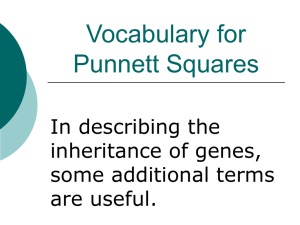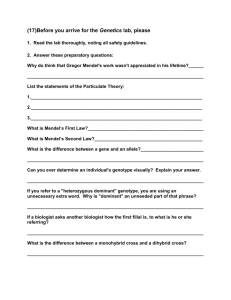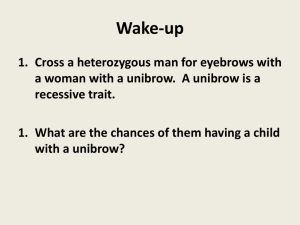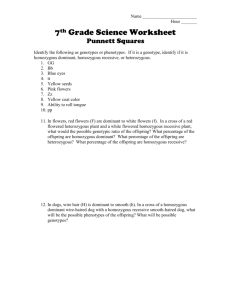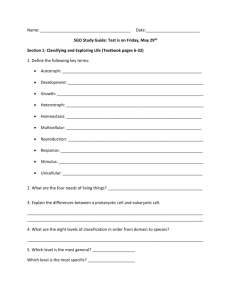Mendelian Genetics
advertisement
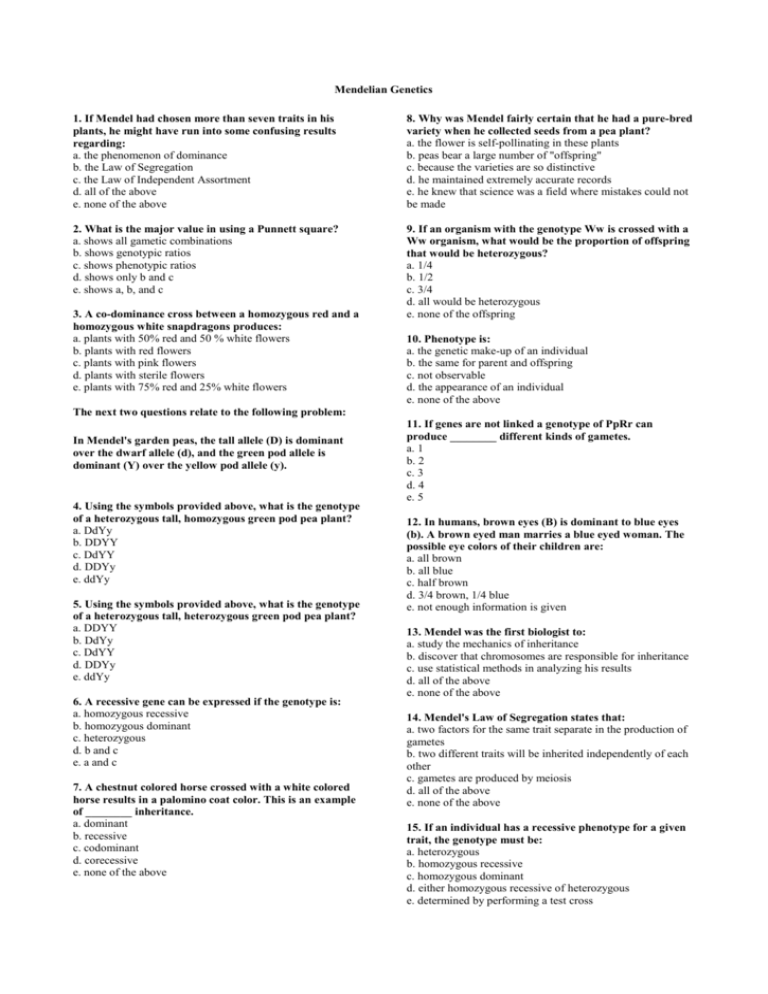
Mendelian Genetics 1. If Mendel had chosen more than seven traits in his plants, he might have run into some confusing results regarding: a. the phenomenon of dominance b. the Law of Segregation c. the Law of Independent Assortment d. all of the above e. none of the above 8. Why was Mendel fairly certain that he had a pure-bred variety when he collected seeds from a pea plant? a. the flower is self-pollinating in these plants b. peas bear a large number of "offspring" c. because the varieties are so distinctive d. he maintained extremely accurate records e. he knew that science was a field where mistakes could not be made 2. What is the major value in using a Punnett square? a. shows all gametic combinations b. shows genotypic ratios c. shows phenotypic ratios d. shows only b and c e. shows a, b, and c 9. If an organism with the genotype Ww is crossed with a Ww organism, what would be the proportion of offspring that would be heterozygous? a. 1/4 b. 1/2 c. 3/4 d. all would be heterozygous e. none of the offspring 3. A co-dominance cross between a homozygous red and a homozygous white snapdragons produces: a. plants with 50% red and 50 % white flowers b. plants with red flowers c. plants with pink flowers d. plants with sterile flowers e. plants with 75% red and 25% white flowers 10. Phenotype is: a. the genetic make-up of an individual b. the same for parent and offspring c. not observable d. the appearance of an individual e. none of the above The next two questions relate to the following problem: In Mendel's garden peas, the tall allele (D) is dominant over the dwarf allele (d), and the green pod allele is dominant (Y) over the yellow pod allele (y). 4. Using the symbols provided above, what is the genotype of a heterozygous tall, homozygous green pod pea plant? a. DdYy b. DDYY c. DdYY d. DDYy e. ddYy 5. Using the symbols provided above, what is the genotype of a heterozygous tall, heterozygous green pod pea plant? a. DDYY b. DdYy c. DdYY d. DDYy e. ddYy 6. A recessive gene can be expressed if the genotype is: a. homozygous recessive b. homozygous dominant c. heterozygous d. b and c e. a and c 7. A chestnut colored horse crossed with a white colored horse results in a palomino coat color. This is an example of ________ inheritance. a. dominant b. recessive c. codominant d. corecessive e. none of the above 11. If genes are not linked a genotype of PpRr can produce ________ different kinds of gametes. a. 1 b. 2 c. 3 d. 4 e. 5 12. In humans, brown eyes (B) is dominant to blue eyes (b). A brown eyed man marries a blue eyed woman. The possible eye colors of their children are: a. all brown b. all blue c. half brown d. 3/4 brown, 1/4 blue e. not enough information is given 13. Mendel was the first biologist to: a. study the mechanics of inheritance b. discover that chromosomes are responsible for inheritance c. use statistical methods in analyzing his results d. all of the above e. none of the above 14. Mendel's Law of Segregation states that: a. two factors for the same trait separate in the production of gametes b. two different traits will be inherited independently of each other c. gametes are produced by meiosis d. all of the above e. none of the above 15. If an individual has a recessive phenotype for a given trait, the genotype must be: a. heterozygous b. homozygous recessive c. homozygous dominant d. either homozygous recessive of heterozygous e. determined by performing a test cross
